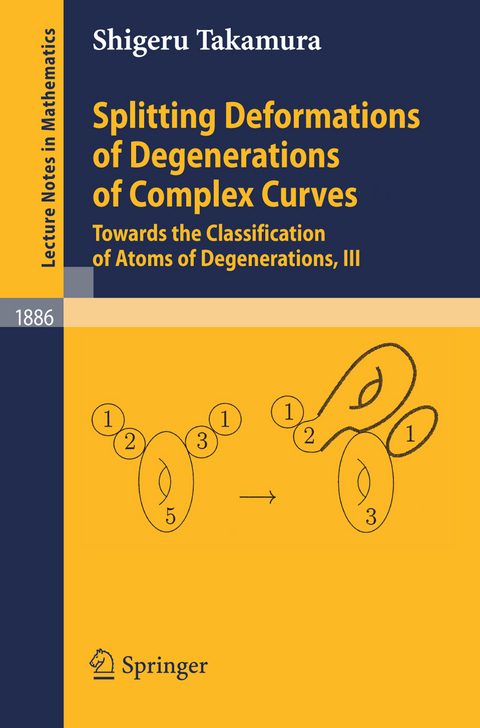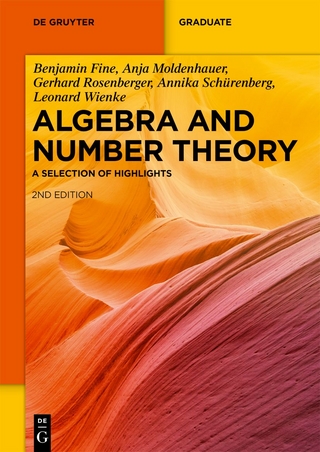Splitting Deformations of Degenerations of Complex Curves
Springer Berlin (Verlag)
978-3-540-33363-0 (ISBN)
The author develops a deformation theory for degenerations of complex curves; specifically, he treats deformations which induce splittings of the singular fiber of a degeneration. He constructs a deformation of the degeneration in such a way that a subdivisor is "barked" (peeled) off from the singular fiber. These "barking deformations" are related to deformations of surface singularities (in particular, cyclic quotient singularities) as well as the mapping class groups of Riemann surfaces (complex curves) via monodromies. Important applications, such as the classification of atomic degenerations, are also explained.
Basic Notions and Ideas.- Splitting Deformations of Degenerations.- What is a barking?.- Semi-Local Barking Deformations: Ideas and Examples.- Global Barking Deformations: Ideas and Examples.- Deformations of Tubular Neighborhoods of Branches.- Deformations of Tubular Neighborhoods of Branches (Preparation).- Construction of Deformations by Tame Subbranches.- Construction of Deformations of type Al.- Construction of Deformations by Wild Subbranches.- Subbranches of Types Al, Bl, Cl.- Construction of Deformations of Type Bl.- Construction of Deformations of Type Cl.- Recursive Construction of Deformations of Type Cl.- Types Al, Bl, and Cl Exhaust all Cases.- Construction of Deformations by Bunches of Subbranches.- Barking Deformations of Degenerations.- Construction of Barking Deformations (Stellar Case).- Simple Crusts (Stellar Case).- Compound barking (Stellar Case).- Deformations of Tubular Neighborhoods of Trunks.- Construction of Barking Deformations (Constellar Case).- Further Examples.- Singularities of Subordinate Fibers near Cores.- Singularities of Fibers around Cores.- Arrangement Functions and Singularities, I.- Arrangement Functions and Singularities, II.- Supplement.- Classification of Atoms of Genus ? 5.- Classification Theorem.- List of Weighted Crustal Sets for Singular Fibers of Genus ? 5.
From the reviews:
"This is a 590 pages book on deformation theory, using mostly topological methods, but also 'translated' to algebraic geometry and using algebraic methods. ... It is a nice level and should be possible to read. Most commonly, algebraic geometers translate from differential geometry to solve problems. In this book the concept is vice versa: Algebraic methods are used to solve topological problems. Thus this book may at the first glance look elementary for an algebraist, but it is not." (Arvid Siqveland, Zentralblatt MATH, Vol. 1100 (2), 2007)
| Erscheint lt. Verlag | 26.7.2006 |
|---|---|
| Reihe/Serie | Lecture Notes in Mathematics |
| Zusatzinfo | XII, 594 p. 123 illus. |
| Verlagsort | Berlin |
| Sprache | englisch |
| Maße | 155 x 235 mm |
| Gewicht | 1870 g |
| Themenwelt | Mathematik / Informatik ► Mathematik ► Algebra |
| Mathematik / Informatik ► Mathematik ► Analysis | |
| Mathematik / Informatik ► Mathematik ► Geometrie / Topologie | |
| Schlagworte | Complex Surface • deformation of complex structures • deformation theory • Monodromy • Riemann surface • Riemann Surfaces • singular fiber |
| ISBN-10 | 3-540-33363-0 / 3540333630 |
| ISBN-13 | 978-3-540-33363-0 / 9783540333630 |
| Zustand | Neuware |
| Informationen gemäß Produktsicherheitsverordnung (GPSR) | |
| Haben Sie eine Frage zum Produkt? |
aus dem Bereich




